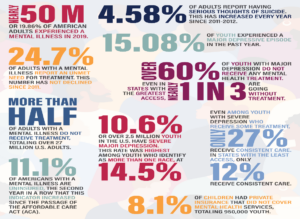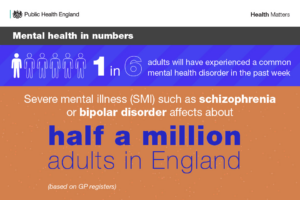Using Mhealth to Combat Mental Health
Redacted Name as Required
Student Name, School
*Name* (Instructor)
Abstract
Mental Health issues have steadily risen in modern-day society. Accessibility could be a barrier, but it may likely be just a matter of inconvenience to act on Mental Health care and services that allow it to rise even as more advancements are made. Using Mental Health tools is better than not using anything, so we must create something new. Over the years, new methods and techniques have been developed with varying results showing increases in effectiveness.
But despite the improvements, the overall mental health estate of modern countries such as the United States and the United Kingdom continue to deteriorate, with varying levels of impact between genders.
By using new research data made available after the invention and push of a promising tool called MHealth, we were able to show a net increase in mental health results likely due to the immediate access available to Mental Health Care from the tool. Despite traditional improvements that have increased the effectiveness of Mental Health Care as it is rendered, it is pointless if mental health services are not utilized to extract the benefit from the public at large. Our findings show that MHealth is positioned as the best answer to increasing the state of Mental Health to a tangible scale in society.
Keywords: Mhealth, Mobile, Accessibility, Screening, Follow-up, Depression, Anxiety
Using Mhealth to Combat Mental Health
Incidences of mental health disorders are heading a troubling trend over the years. As human capabilities and knowledge increase, improvements in the state of mental health across society do not seem to be improving as expected. Lack of accessibility and convenience could be what is hindering mental health care from reaching the level of impact desired.
The World Health Organization reported a 25% increase in mental health incidences globally during the pandemic, especially among young adults (Kola et al., 2022). According to Kessler et al. (2022), the prevalence of mental health illnesses increased significantly in the United States during the COVID-19 pandemic when compared to the years before the pandemic.
The significance of mental health in America is further confirmed by the constantly increasing medication trends for mental illnesses in the country since 2001 (Medco, 2011; County Health Rankings & Roadmaps, 2018). A report by the Australian National Health Survey (ANHS) indicates that there has been a rising trend in the level of psychological distress among members of Australia’s population.
Efforts to reduce these rates have been hampered by the lack of access to mental health services (Enticott et al., 2022). Movement restrictions imposed by governments during the COVID-19 pandemic worsened the health outcomes of affected individuals who could not access mental healthcare services at home.
As a response to limited accessibility to mental healthcare services, MHealth was created to increase access to mental health care services across populations (Achtyes et al., 2021). Chandrashekar (2018) defines Mhealth as a set of wireless mobile devices and apps that support communication in the field of health care. In this paper, the author will explore the state of Mental Health in the United States and United Kingdom, how advancements in care did not translate to meaningful improvements over the years, the creation of MHealth as a tool to combat mental health, and the promising results it has shown.
Literature Review
The State of Mental Health in the United States and the United Kingdom
Both the United States and the United Kingdom have reported rising incidences and prevalence of mental health issues in the recent past. According to the Centers for Disease Control and Prevention (2021), mental health problems are among the health conditions that are commonly diagnosed among the United States population. The CDC further reports that America records approximately 20% of new mental health cases each year. Schizophrenia, anxiety, depression, and bipolar disorders are the conditions that are often reported in the United States.
Coombs et al. (2021) identified affordability and geographical determinants as the major factors that are hindering mental health access in the United States. While citing geographical barriers, rural inhabitants reported long travel distances and inadequate human and non-human resources allocated to the few health services available. Limited access to mental health services leads to negative health outcomes such as increased morbidity and mortality. Figure 1 below shows the status of mental health in the United States.
Figure 1: The Status of Mental Health in the United States

The United Kingdom Mental Health Foundation reported rising incidences and prevalence of mental health problems among members of the country’s population. A survey conducted by the agency revealed that about 65% of the population reported having experienced mental illnesses in their lifetime.
Despite the country’s effort to combat mental health problems, a small minority group still reports negative health outcomes caused by severe forms of the disease (Mental Health Foundation, 2022). Australia is among those countries of the United Kingdom that usually report increasing incidences and prevalence of mental illnesses across age groups (Enticott et al., 2022).
Maconick et al. (2021) conducted a cross-sectional study to assess geographical variation in mental health services utilization in England, United Kingdom. Among other findings, the results of the study indicate that minority groups who reside in densely populated rural areas experienced challenges accessing mental health services. The researchers proposed the need to implement interventions that will address the observed geographical variations in mental health services utilization. Figure 2 below shows the status of mental health in the United Kingdom.
Figure 2: the Status of Mental Health in the United Kingdom

The Unmet Needs
Different countries around the world are making efforts to keep rates of mental health illnesses low and reduce negative health outcomes for their citizens. Although such interventions have resulted in positive outcomes, they have not generated meaningful improvements over the years. In this regard, healthcare organizations are now implementing digital and technological interventions to increase populations’ access to mental health services and improve their mental well-being (De Witte et al., 2021). People with mental health problems have several needs that can best be addressed through the use of an integrated healthcare delivery model.
Discharge planning and conducting physical follow-up may not generate meaningful outcomes for some patients, especially for those patients who reside in locations that are not easily accessible. Ihantamalala et al. (2021) cited poor geographical accessibility as a major barrier to successful hospital referrals and patient follow-up. This calls for the need to devise strategies to increase healthcare access to patients who reside in regions that normally experience geographical challenges as barriers to healthcare access.
Mhealth as a Tool to Combat Mental Health and Its Promising Results
Mhealth technology offers solutions to mental health screening, particularly for populations that cannot easily access healthcare settings. According to Funnell et al. (2022), the creation of mhealth has expanded the use of mobile apps for screening for mental health illnesses across populations. In order to enhance the effectiveness of these apps, it is recommended that they are designed in a user-friendly manner to reduce dropout rates.
Women who are receiving perinatal services are often diagnosed with mental health services just like other members of the population. In their study, Spadaro et al. (2022) examined the effectiveness of mhealth in facilitating mental health screening in perinatal women. From the study, the researchers found that mhealth provides a great opportunity for promoting mental health screening among perinatal women. These findings present mhealth as a tool that increases access to mental health services for underrepresented populations.
Mhealth expands access to mental health services for patients who have already been diagnosed with mental illnesses, thereby enhancing the realization of positive health outcomes. Mental health symptoms affect the quality of life of patients with different types of mental disorders (Serrano-Ripoll et al., 2022). According to Serrano-Ripoll et al. (2022), mhealth interventions that specifically target patients with depression generate meaningful reductions in disease symptoms thereby improving patients’ quality of life.
Similar findings are supported by Huang et al. (2022) who reported that mhealth interventions such as WeChat have proven effective in improving the mental health outcomes of hospitalized patients with depression. Evidence documented by Chandrashekar (2018) suggests that mhealth has helped to improve symptoms of a wide range of mental illnesses including bipolar disorder, generalized anxiety disorder, suicidal depression, and schizophrenia among other mental illnesses among vulnerable populations experiencing accessibility challenges.
Discussion
Published literature supports the hypothesis that mhealth is effective in combating mental health problems among vulnerable populations by increasing access to mental health care services. Hospitalized mental health patients require close monitoring and follow-up post-discharge (Achtyes et al., 2021). They need to keep close contact with a team of healthcare providers to offer the support that they need for effective self-care management at home.
Reaching these patients physically can be a great challenge for healthcare professionals who now find the wireless mhealth technology useful in facilitating timely referral and monitoring of mental health patients post-discharge thereby enhancing self-care management at home (Ihantamalala et al., 2021). Using the technology, patients can share their health concerns with a team of healthcare providers remotely thereby enhancing recovery.
The mhealth tool can be applied in addressing the underutilization of mental health services that are witnessed in the United States and the United Kingdom. As Mackenzie et al. (2006) report, there is widespread underutilization of mental health services across people of different age groups and gender. A number of factors have been linked with the observed underutilization. These factors include geographical inaccessibility, long distances between places of residence and healthcare facilities, and negative attitudes toward mental health services.
Research evidence indicates that mhealth has successfully been used to address the underutilization of mental health services (Coombs et al., 2021). For example, healthcare professionals use mhealth to remotely connect with mental health patients in rural areas. They utilize the opportunity to educate patients about the importance of seeking medical advice following a confirmed diagnosis of a mental illness. Through such interactions, mental health professionals are able to address the negative attitudes towards mental health interventions thereby increasing the utilization of mental health services.
Some patients usually experience negative mental health outcomes due to delayed diagnosis. Patients whose mental health problems are identified late might need extra care depending on the severity of their symptoms (Funnel et al., 2022). The best way to combat such negative impacts is to identify at-risk patients early, conduct mental health assessments, and begin treatment early for positive cases.
Mhealth technology provides a good opportunity for facilitating mental health screening across populations. Healthcare professionals can use the technology to evaluate populations that are at risk of developing mental illnesses such as perinatal and postpartum women Funnel et al., 2022). However, it is important to note that people who are confirmed to be at risk of developing mental illnesses should not be considered positive cases. A comprehensive mental health assessment is necessary to find out whether a mental illness actually exists.
The effectiveness of mhealth technology largely depends on the patient’s ability to use the technology and the ability of the apps to address patients’ problems. In this respect, it is important to design telehealth apps in a manner that they can easily be used by the patient (Funnel et al., 2022). For example, it is imperative that a mentally ill patient understand how to use relevant apps to reach his or her healthcare provider.
This can be achieved when the apps are kept simple and user-friendly. Additionally, strategies must be put in place to enhance the patient’s safety while using mhealth. For example, appropriate measures to protect patient privacy and confidentiality will help to prevent unauthorized access to patient data (Mackenzie et al., 2006; Chandrashekar, 2018). Such strategies can prevent patients from developing negative attitudes towards mental health services and from dropping out from already initiated mental health interventions.
Conclusion
Rates of mental health problems continue to rise despite the efforts made by countries to combat these illnesses. Poor accessibility of mental health services has been linked with their underutilization. One of the factors that are hindering populations from accessing mental health services is inaccessible geographical areas, due to either the poor physical terrain or long distances.
People who reside in these areas are unable to benefit from the mental health services located in the urban areas. Besides, mental healthcare services in rural areas experience a shortage of both human and non-human mental healthcare resources.
In both the United States and the United Kingdom, minority groups who reside in densely populated rural areas experience challenges accessing mental health services. The lack of access to mental health services is associated with negative health outcomes for patients. With the increase in human knowledge and technological advancements, tools such as mhealth are now available and are widely used by healthcare systems to increase mental health care access for vulnerable populations. The effectiveness of mhealth in combating mental health problems is supported by research-based evidence.
The technology is useful in facilitating timely referral and monitoring of mental health patients post-discharge thereby enhancing self-care management at home. It also offers an opportunity for mental health providers to reach at-risk populations and screen them for mental health problems before organizing a comprehensive diagnosis and treatment for them.
Mental health professionals have successfully used mhealth to monitor and manage symptoms of a wide range of mental illnesses including bipolar disorder, generalized anxiety disorder, suicidal depression, and schizophrenia among other mental illnesses among vulnerable populations experiencing accessibility challenges. Used as both a screening and a symptom monitoring tool, mhealth can be used to combat mental health in different settings and geographical locations.
References
Achtyes, E. D., Gega, L., & Linnaranta, O. (2021). Editorial: Mhealth: Self-management and complementary psychiatric treatment. Frontiers in Psychiatry, 12. https://doi.org/10.3389/fpsyt.2021.777090
Centers for Disease Control and Prevention. (2021). About mental health. https://www.cdc.gov/mentalhealth/learn/index.htm#:~:text=1%20in%205%20Americans%20will,illness%20in%20a%20given%20year.&text=1%20in%205%20children%2C%20either,a%20seriously%20debilitating%20mental%20illness.&text=1%20in%2025%20Americans%20lives,bipolar%20disorder%2C%20or%20major%20depression.
Chandrashekar, P. (2018). Do mental health mobile apps work: evidence and recommendations for designing high-efficacy mental health mobile apps. mHealth, 4, 6. https://doi.org/10.21037/mhealth.2018.03.02
Coombs, N. C., Meriwether, W. E., Caringi, J., & Newcomer, S. R. (2021). Barriers to healthcare access among U.S. adults with mental health challenges: A population-based study. SSM – Population Health, 15, 100847. https://doi.org/10.1016/j.ssmph.2021.100847
County Health Rankings & Roadmaps. (2018). Mobile Health for Mental Health. https://www.countyhealthrankings.org/take-action-to-improve-health/what-works-for-health/strategies/mobile-health-for-mental-health#:~:text=Mobile%20health%2C%20also%20known%20as,PTSD)%2C%20and%20substance%20abuse
De Witte, N., Joris, S., Van Assche, E., & Van Daele, T. (2021). Technological and digital interventions for mental health and wellbeing: An overview of systematic reviews. Frontiers in Digital Health, 3, 754337. https://doi.org/10.3389/fdgth.2021.754337
Enticott, J., Dawadi, S., Shawyer, F., Inder, B., Fossey, E., Teede, H., Rosenberg, S., Ozols Am, I., & Meadows, G. (2022). Mental health in Australia: Psychological distress reported in six consecutive cross-sectional national surveys from 2001 to 2018. Frontiers in Psychiatry, 13, 815904. https://doi.org/10.3389/fpsyt.2022.815904
Funnell, E. L., Spadaro, B., Martin-Key, N., Metcalfe, T., & Bahn, S. (2022). mHealth solutions for mental health screening and diagnosis: A review of app user perspectives using sentiment and thematic analysis. Frontiers in Psychiatry, 13, 857304. https://doi.org/10.3389/fpsyt.2022.857304
Huang, L., Li, V. W., Yang, T., Liu, J., Murphy, J., Michalak, E. E., Wang, Z., Ng, C., Yatham, L., Chen, J., & Lam, R. W. (2022). Mobile health applications for depression in China: A systematic review. Cureus, 14(7), e27299. https://doi.org/10.7759/cureus.27299
Ihantamalala, F. A., Bonds, M. H., Randriamihaja, M., Rakotonirina, L., Herbreteau, V., Révillion, C., Rakotoarimanana, S., Cowley, G., Andriatiana, T. A., Mayfield, A., Rich, M. L., Rakotonanahary, R., Finnegan, K. E., Ramarson, A., Razafinjato, B., Ramiandrisoa, B., Randrianambinina, A., Cordier, L. F., & Garchitorena, A. (2021). Geographic barriers to establishing a successful hospital referral system in rural Madagascar. BMJ Global Health, 6(12), e007145. https://doi.org/10.1136/bmjgh-2021-007145
Kessler, R. C., Chiu, W. T., Hwang, I. H., Puac-Polanco, V., Sampson, N. A., Ziobrowski, H. N., & Zaslavsky, A. M. (2022). Changes in prevalence of mental illness among US adults during compared with before the COVID-19 pandemic. The Psychiatric Clinics of North America, 45(1), 1–28. https://doi.org/10.1016/j.psc.2021.11.013
Kola, L., Kumar, M., Kohrt, B. A., Fatodu, T., Olayemi, B. A., & Adefolarin, A. O. (2022). Strengthening public mental health during and after the acute phase of the COVID-19 pandemic. Lancet (London, England), 399(10338), 1851–1852. https://doi.org/10.1016/S0140-6736(22)00523-2
Mackenzie, C. S., Gekoski, W. L., & Knox, V. J. (2006). Age, gender, and the underutilization of mental health services: The influence of help-seeking attitudes. Aging & Mental Health, 10(6), 574–582. https://doi.org/10.1080/13607860600641200
Maconick, L., Sheridan Rains, L., Jones, R., Lloyd-Evans, B., & Johnson, S. (2021). Investigating geographical variation in the use of mental health services by area of England: a cross-sectional ecological study. BMC Health Services Research, 21(1), 951. https://doi.org/10.1186/s12913-021-06976-2
Medco. (2011). America’s State of Mind. http://www.antoniocasella.eu/archipsy/Medco_2011.pdf
Mental Health Foundation. (2022). Surviving or thriving? The state of UK’s mental health. https://www.mentalhealth.org.uk/explore-mental-health/publications/surviving-or-thriving-state-uks-mental-health#:~:text=Nearly%20two%2Dthirds%20of%20people,levels%20of%20positive%20mental%20health.
Serrano-Ripoll, M. J., Zamanillo-Campos, R., Fiol-DeRoque, M. A., Castro, A., & Ricci-Cabello, I. (2022). Impact of smartphone app-based psychological interventions for reducing depressive symptoms in people with depression: Systematic literature review and meta-analysis of randomized controlled trials. JMIR mHealth and uHealth, 10(1), e29621. https://doi.org/10.2196/29621
Spadaro, B., Martin-Key, N. A., Funnell, E., & Bahn, S. (2022). MHealth solutions for perinatal mental health: scoping review and appraisal following the Mhealth index and navigation database framework. JMIR MHealth and UHealth, 10(1), e30724. https://doi.org/10.2196/30724
